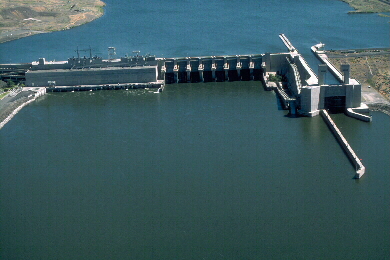forum
library
tutorial
contact

BPA Says It's Ready for
Dry-year Power Demands
by News Sources
KTVZ, May 10, 2015
|
the film forum library tutorial contact |

|
BPA Says It's Ready for
by News Sources
|
'We've been through this before'
 PORTLAND, OR -- The BonnevillePower Administration said Friday it is positioned to meet the ongoing power needs of its customers, as well as its non-power obligations, including those aimed at protecting fish.
PORTLAND, OR -- The BonnevillePower Administration said Friday it is positioned to meet the ongoing power needs of its customers, as well as its non-power obligations, including those aimed at protecting fish.
BPA said the agency and its federal partners have been monitoring the downward trend in water supply forecasts throughout the winter and spring and are prepared to manage the system through the remainder of the spring and summer.
BPA, the U.S. Army Corps of Engineers and the Bureau of Reclamation are working closely with input from the Technical Management Team to determine the best way to meet the needs of fish migrating in the Columbia River with a limited amount of water.
The TMT is a collaborative group of federal, state and tribal representatives who make recommendations to the federal agencies regarding the implementation of the Biological Opinions for the Federal Columbia River Power System.
"We don't have as much water as we would like, but we're well-prepared to handle the current situation," said Kieran Connolly, vice president of Generation Asset Management for BPA. "We've been through this before - as recently as 2010. We plan extensively every year, so we don't get caught flat-footed."
Dry year operations are implemented when the May final April-through-August forecast from the Northwest River Forecast Center for total volume runoff at The Dalles Dam is less than 72.2 million acre-feet (maf). One acre-foot is a volume of water equivalent to one acre covered one foot deep with water - it's a little more than 325,000 gallons. The Northwest River Forecast Center's final May forecast, released on Thursday, is 62.4 maf.
The forecasted low runoff this year is not due to a lack of precipitation, but above-normal temperatures that caused much of the precipitation to fall as rain instead of snow, particularly in the U.S. portions of the Columbia Basin.
Federal planners and operators have monitored water supply conditions as the year has progressed and planned accordingly, preparing them to manage the system to meet the multiple purposes of the FCRPS through the remainder of the year.
Typically, when the BiOp dry year operations are triggered, reservoirs are drawn down further than normal to provide more water for fish. One of the significant benefits of reservoirs is the ability to catch water and reduce the chances of flooding, or as is the case this year, release stored water during drier times.
The last time the BiOp's dry year criteria were triggered occurred in 2010, although abundant late spring precipitation improved runoff conditions and resulted in a final runoff volume of 77 maf at The Dalles Dam. There is currently no climatological signal indicating such a recovery is in store for this year.
"We're ready and prepared to respond to conditions as they unfold," Connolly reiterated. "This year also serves as a great reminder that it is always good to use energy wisely, both at home and work."
BPA is a nonprofit federal agency that markets renewable hydropower from federal Columbia Basin dams, operates three-quarters of high-voltage transmission lines in the Northwest and funds one of the largest wildlife protection and restoration programs in the world. BPA and its partners have also saved enough electricity through energy efficiency projects to power four large American cities. For more information, contact us at 503-230-5131 or visit www.bpa.gov
learn more on topics covered in the film
see the video
read the script
learn the songs
discussion forum
